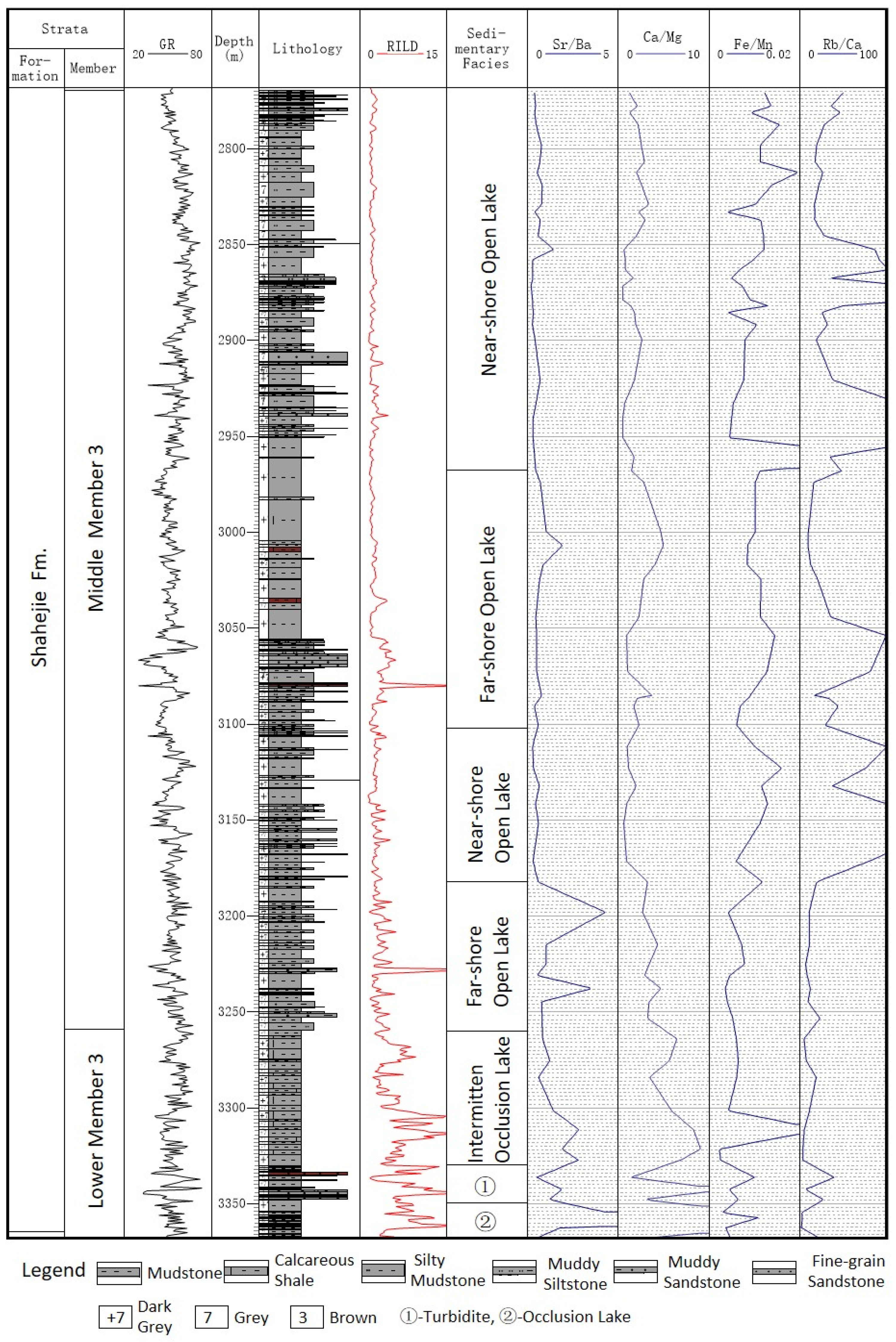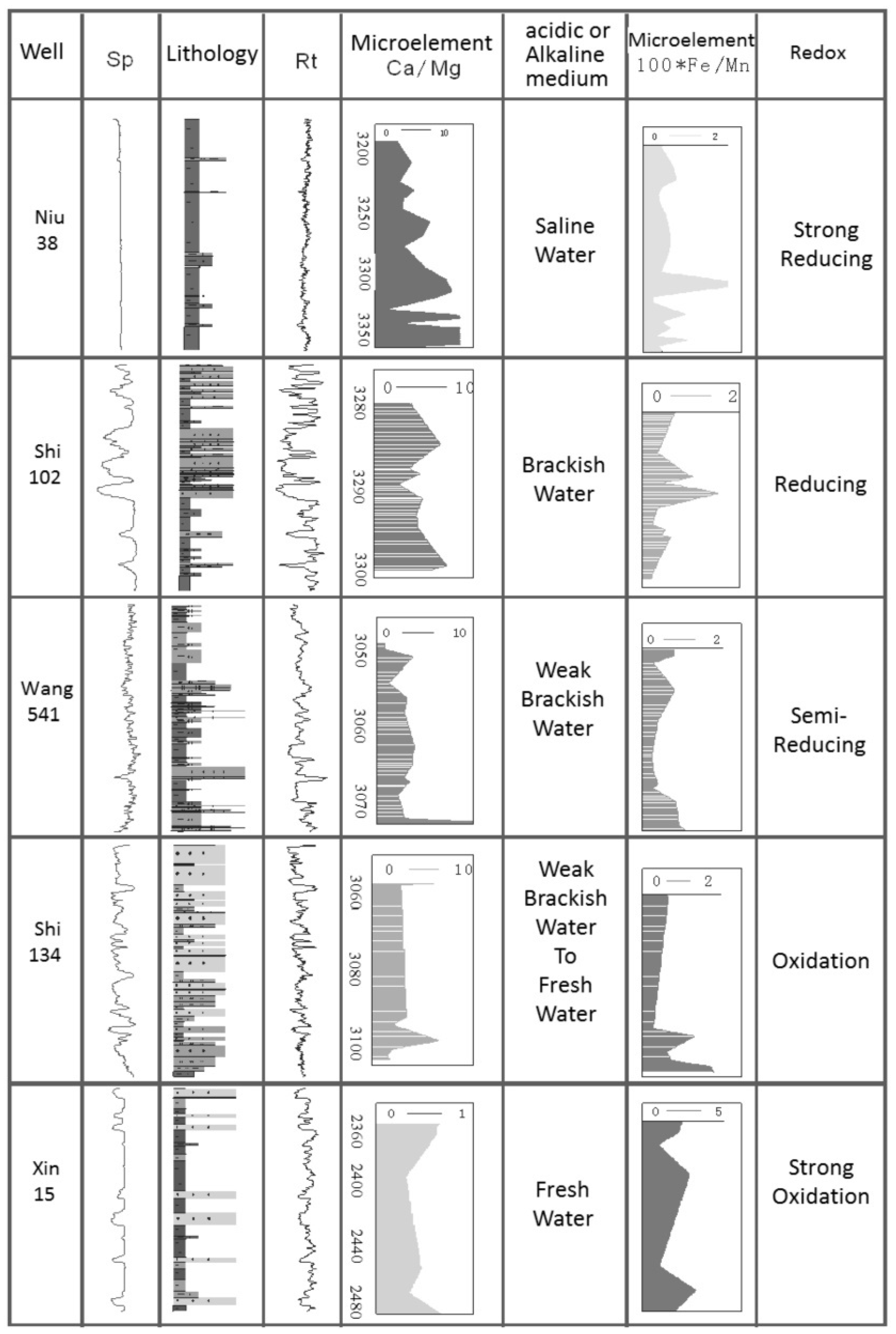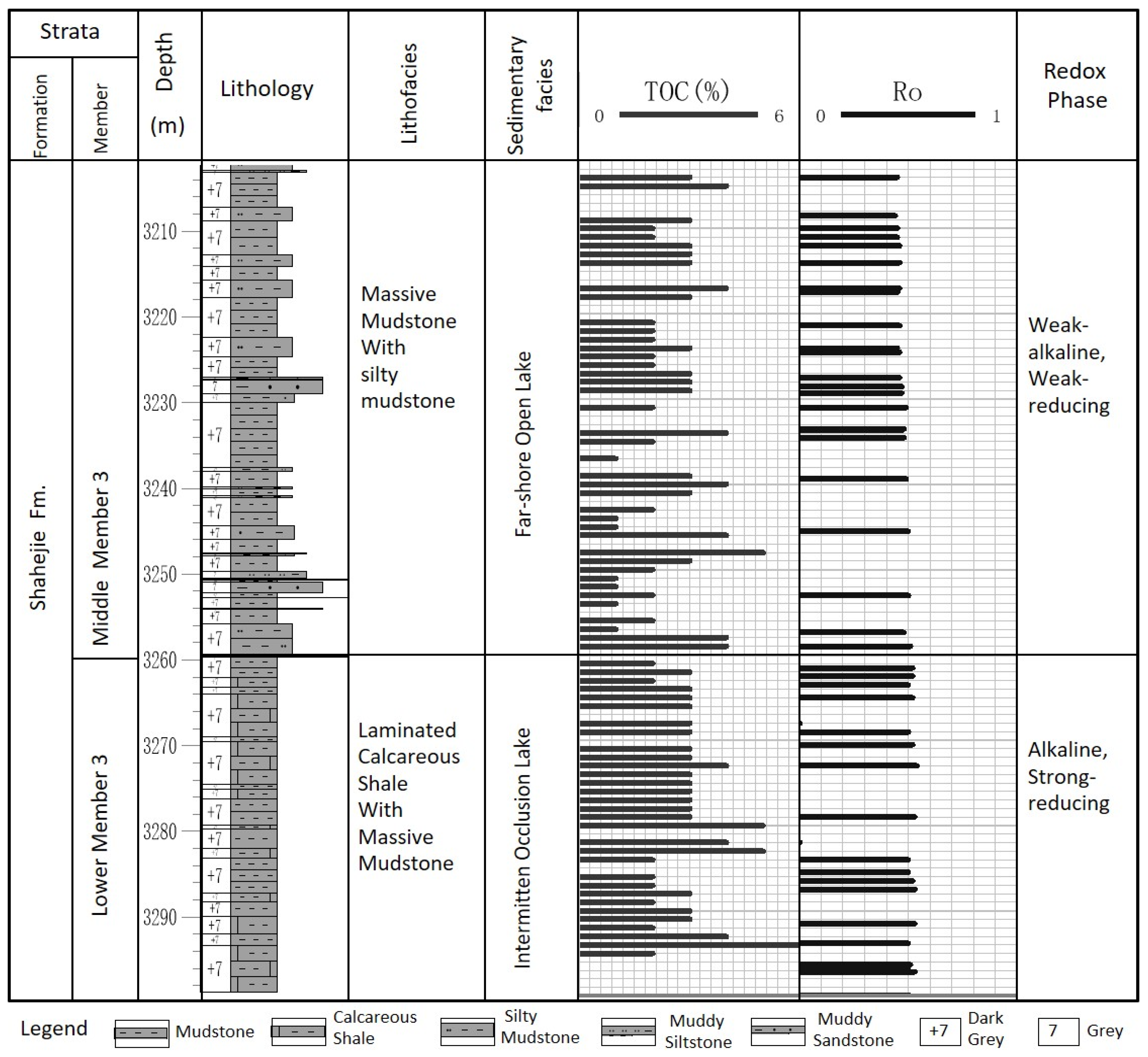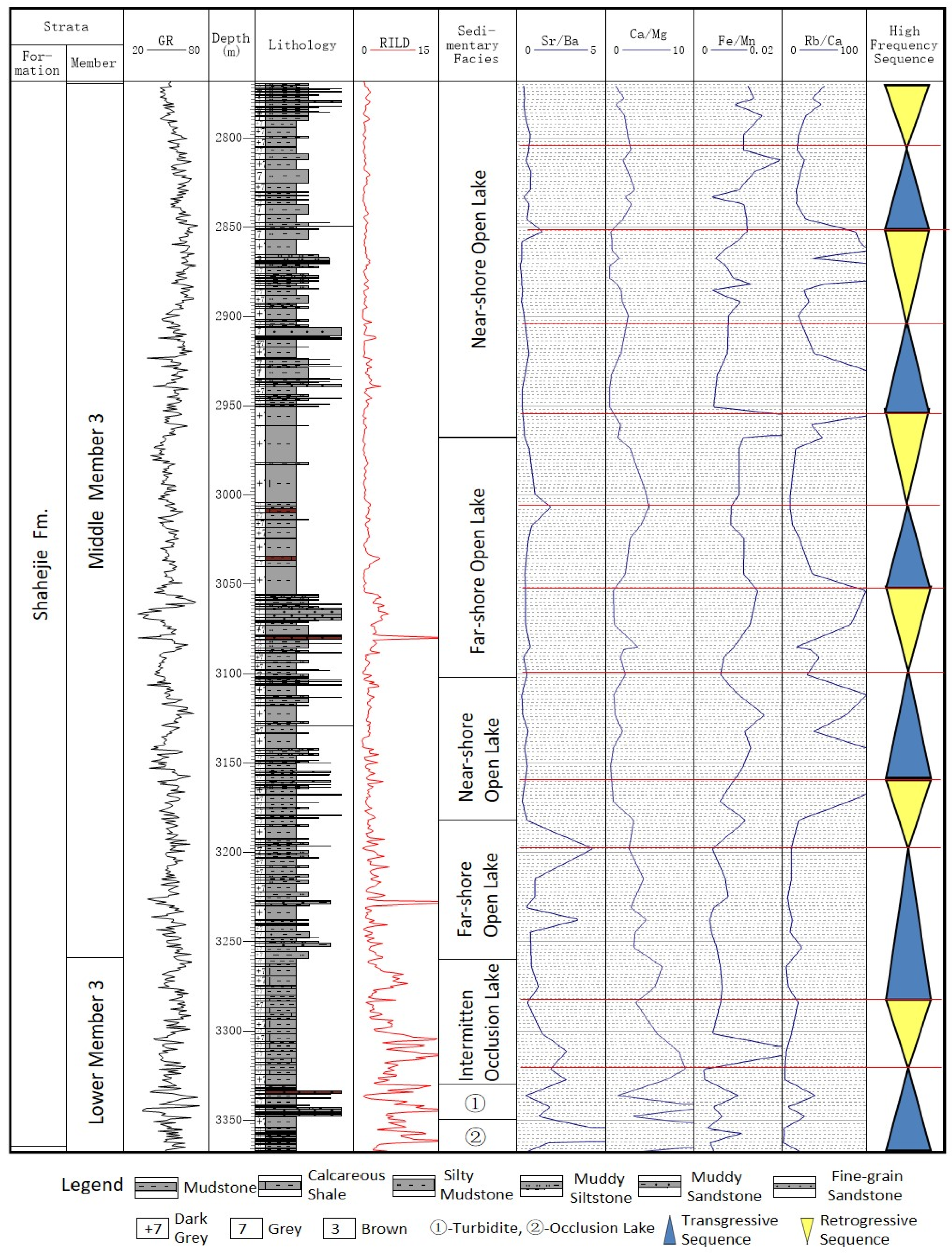Application of Elemental Geochemistry in High-Frequency Sequence—Stratigraphic Analysis of Lacustrine Shale
Abstract
:1. Introduction
2. Data and Methods
3. Results and Discussions
3.1. Elemental Ratios
Elemental Ratios as Indicators for Facies
3.2. TOC Changes in Different Lake Shale Sediments
3.3. Relationship Between the Change of Element Ratios and High-Frequency Sequence Stratigraphy Division in Shale
4. Conclusions
- (1)
- During the evolution of the lake basin, the depositional environment changes from salt lake to blocked lake, open lake, and finally delta. As the decrease of sediment transport, the salinity of the ancient water becomes lighter, and the element ratio also changes accordingly. Especially, during the above evolution, the Sr/Ba and Ca/Mg ratios increase, and the Rb/Ca and Fe/Mn ratios are increased.
- (2)
- The content of organic matter is high in occluded lake facies, intermittent lake facies, and open lake facies mudstone. Organic matter preservation can be damaged when the water depth becomes shallower, the hydrodynamic energy increases, and the reduction conditions become weaker. The stratification of lake water is beneficial for organic matter accumulation and preservation.
- (3)
- The element geochemical ratios can be used for high-frequency sequence stratigraphic division of lacustrine shale. The Sr/Ba and Ca/Mg ratios near the sequence boundary are low and the Fe/Mn and Rb/Ca ratios are high, while the Sr/Ba and Ca/Mg ratios near the flooding surface are high and the Fe/Mn and Rb/Ca ratios are low. The relationship between those element ratios and high-frequency sequences is initially established in the lake shale profile.
Supplementary Materials
Author Contributions
Funding
Acknowledgments
Conflicts of Interest
References
- Macquaker, J.H.S.; Gawthorpe, R.L. Mudstone Lithofacies in the Kimmeridge Clay Formation, Wessex Basin, Southern England: Implications for the Origin and Controls of the Distribution of Mudstones: REPLY. J. Sediment. Res. 1993, 63, 1129–1143. [Google Scholar]
- Montgomery, S.L.; Jarvie, D.M.; Bowker, K.A.; Pollastro, R.M. Mississippian Barnett Shale, Fort Worth basin, north-central Texas: Gas-shale play with multi–trillion cubic foot potential. AAPG Bull. 2005, 89, 155–175. [Google Scholar] [CrossRef]
- Liu, Z.J.; Meng, Q.T.; Liu, R. Characteristics and genetic types of continental oil shales in China. J. Palaeogeogr. 2009, 11, 105–114. [Google Scholar]
- Li, Y.X.; Nie, H.K.; Long, P.Y. Development characteristics of organic-rich shale and strategic selection of shale gas exploration area in China. Nat. Gas Ind. 2009, 29, 115–118. [Google Scholar]
- Loucks, R.G.; Ruppel, S.C. Mississippian Barnett Shale: Lithofacies and depositional setting of a deep-water shale-gas succession in the Fort Worth Basin, Texas. AAPG Bull. 2007, 91, 579–601. [Google Scholar] [CrossRef] [Green Version]
- Wang, G.; Liang, G. Identification of Aeolian Silty Sand in Lacustrine Shale of the Shahejie Formation in the Jiyang Depression and Its Indication to Paleoclimate. Acta Geol. Sin. 2007, 81, 413–418. [Google Scholar]
- Liu, C.; Shu, X.; Liu, Z. Micro-characteristics of Paleogene lacustrine petroleum source rocks in Jiyang depressio. Acta Sedimentol. Sin. 2001, 19, 293–298. [Google Scholar]
- Wignall, P.B. Mudstone Lithofacies in the Kimmeridge Clay Formation, Wessex Basin, Southern England: Implications for the Origin and Controls of the Distribution of Mudstones: Discussion and reply. J. Sediment. Res. 1994, 64, 927–929. [Google Scholar] [CrossRef]
- Macquaker, J.H.S. A lithofacies study of the Peterborough Member, Oxford Clay Formation (Jurassic), UK: An example of sediment bypass in a mudstone succession. J. Geol. Soc. Lond. 1994, 151, 161–172. [Google Scholar] [CrossRef]
- Deng, H.; Qian, K. Sedimentary Geochemistry and Environment Analysis; Gansu Science and Technology Press: Lanzhou, China, 1993. [Google Scholar]
- Kulpecz, A.A.; Miller, K.G.; Sugarman, P.J.; Browning, J.V. Response of late cretaceous migrating deltaic facies systems to sea level, tectonics, and sediment supply changes, New Jersey coastal plain, USA. J. Sediment. Res. 2008, 78, 112–129. [Google Scholar] [CrossRef]
- Flocks, J.G.; Ferina, N.F.; Dreher, C.; Kindinger, J.L.; Fitzgerald, D.M.; Kulp, M.A. High-Resolution Stratigraphy of a Mississippi Subdelta-Lobe Progradation in the Barataria Bight, North-Central Gulf of Mexico. J. Sediment. Res. 2006, 76, 429–443. [Google Scholar] [CrossRef]
- Pietras, J.T.; Carroll, A.R. High-resolution sequence stratigraphy and strontium isotope geochemistry of Lacustrine Wilkins Peak Member, Eocene Green River Formation, Wyoming, U.S.A. J Sediment. Res. 2006, 76, 1197–1214. [Google Scholar] [CrossRef]
- Janok, P.; Bhattacharya, B.J.W. Lowstand deltas in the Frontier Formation, Powder River basin, Wyoming: Implications for sequence stratigraphic models. AAPG Bull. 2001, 85, 261–294. [Google Scholar]
- Williams, C.J.; Hesselbo, S.P.; Jenkyns, H.C.; Morgans Bell, H.S. Quartz silt in mudrocks as a key to sequence stratigraphy (Kimmeridge Clay Formation, Late Jurassic, Wessex Basin, UK). Terra Nova 2001, 13, 449–455. [Google Scholar] [CrossRef]
- Bohacs, K.M. Contrasting expressions of depositional sequences in mudrocks from marine to non marine environs. In Shales and Mudstones: Recent Progress in Shale Research; Schieber, J., Zimmerle, W., Sethi, P.S., Eds.; Schweizerbart’sche Verlagsbuchhandlung: Stuttgart, Germany, 1988; pp. 33–78. [Google Scholar]
- Macquaker, J.H.S.; Taylor, K.G. A sequence-stratigraphic interpretation of a mudstone-dominated succession: The Lower Jurassic Cleveland Ironstone Formation, UK. J. Geol. Soc. Lond. 1996, 153, 759–770. [Google Scholar] [CrossRef]
- Vidier, J.P.H.A. Sequence stratigraphy of source rocks applied to the study of the Kim meridgian/Tithonian in the north-west European shelf (Dorset/UK, Yorkshire/UK and Boulonnais/France). Mar. Petrol. Geol. 1995, 12, 177–194. [Google Scholar]
- Stephen, C.; Passe, Q.R. Recurring Patterns of Total Organic Carbon and Source Rock Quality within a Sequence Stratigraphic Framework. Bulletin 1993, 77, 386–401. [Google Scholar]
- Bohacs, K.L.R. Sequence stratigraphy in fine-grained rocks at the field to flow-unit scale: Insights for correlation, mapping, and genetic controls. In Proceedings of the Applied Geoscience Conference (AGC), Houston, TX, USA, 8 February 2010. [Google Scholar]
- May, J.A.; Anderson, D.S. Mudrock reservoir deposition and stratigraphy: Not homogenous, not boring. In Proceedings of the AAPG/SEG/SPE/SPWLA Hedberg Conference “Critical Assessment of Shale Resource Plays”, Houston, TX, USA, 5–10 December 2010. [Google Scholar]
- Wu, J.; Jiang, Z.; Tong, J.; Yang, L.; Nie, H. Sedimentary environment and control factors of fine-grained sedimentary rocks in the upper fourth Member of Paleogene Shahejie Formation, Dongying sag. Acta Pet. Sin. 2016, 37, 464–473. [Google Scholar]
- Li, Y.F.; Shao, D.Y.; Lv, H.S.; Zhang, Y.; Zhang, X.L.; Zhang, T.W. A relationship between elemental geochemical characteristics and organic matter enrichment in marine shale of Wufeng Formation—Longmaxi Formation, Sichuan Basin. Acta Pet. Sin. 2015, 36, 1470–1483. [Google Scholar]
- Guo, L.Y.; Zhong-Sheng, L.I.; Xie, X.N.; Shang, F.; Fan, Z.H.; Liu, Z.J.; Feng, W.U. High-frequency Variation of Geochemical Elements and Its Geological Implication on Lacustrine Organic-rich Mudstone and Shale Formation: An Example from the Core-taking Segment of Well BY1 in the Biyang Depression. Geoscience 2015, 29, 1360–1370. [Google Scholar]
- Jin, F.M.; Han, C.Y.; Wang, J.M.; Guo, Y.J.; Gao, Z.H. Application of Organic Geochemical parameters in sequence classification and correlation: A case study from Lower Es3 in Shulu Sag, Jizhong Depression. Acta Sedimentol. Sin. 2008, 26, 86. [Google Scholar]
- Zhang, L.; Li, Z.; Zhu, R. Resource potential of shale gas in paleogene in jiyang depression. Nat. Gas Ind. 2008, 28, 26–29. [Google Scholar]
- Liu, X.M.; Wang, S.J.; Sun, C.X.; Jia, Y.H.; Li, T.Y. Strontium as an essential indicator of paleosalinity. Acta Mineral. Sin. 2000, 20, 91–96. [Google Scholar]
- Dedeckker, P.; Last, W.M. Modern dolomite deposition in continental, saline lakes, western Victoria, Australia. Geology 1988, 16, 29–32. [Google Scholar] [CrossRef]
- Nelson, C.H. Sediments of Crater Lake, Oregon. GSA Bull. 1967, 78, 833. [Google Scholar] [CrossRef]




| Scheme | Un-Occlusive Lake | Occlusive Lake | Intermittent Occlusive Lake | Open Lake | Turbidity Mudstone | |
|---|---|---|---|---|---|---|
| Far Shore | Near Shore | |||||
| Lithofacies | Gray Mudstone | Black Shale | Calcareous Laminas Shale | Even Massive Mudstone Horizontally Bedded Mudstone | Gray Mudstone | Uneven Massive Mudstone |
| TOC (%) | ||||||
| Sample | Depth (m) | TOC (%) | Sample | Depth (m) | TOC (%) | Sample | Depth (m) | TOC (%) |
|---|---|---|---|---|---|---|---|---|
| 1 | 3203.0 | 4.0 | 29 | 3239.7 | 3.2 | 57 | 3273.2 | 4.0 |
| 2 | 3204.1 | 2.1 | 30 | 3240.1 | 1.9 | 58 | 3274.1 | 3.2 |
| 3 | 3204.6 | 2.9 | 31 | 3241.0 | 3.1 | 59 | 3275.6 | 3.1 |
| 4 | 3205.1 | 3.9 | 32 | 3243.2 | 2.0 | 60 | 3276.3 | 3.0 |
| 5 | 3209.0 | 3.0 | 33 | 3244.3 | 1.2 | 61 | 3277.2 | 2.2 |
| 6 | 3210.2 | 2.1 | 34 | 3245.8 | 1.3 | 62 | 3277.8 | 3.1 |
| 7 | 3211.1 | 2.0 | 35 | 3246.5 | 4.2 | 63 | 3278.5 | 2.9 |
| 8 | 3212.3 | 3.1 | 36 | 3248.0 | 5.0 | 64 | 3279.4 | 2.0 |
| 9 | 3213.2 | 2.9 | 37 | 3249.1 | 3.3 | 65 | 3279.9 | 3.1 |
| 10 | 3214.6 | 2.9 | 38 | 3250.2 | 2.1 | 66 | 3280.2 | 2.0 |
| 11 | 3217.1 | 3.0 | 39 | 3251.5 | 1.1 | 67 | 3280.7 | 4.9 |
| 12 | 3217.5 | 4.0 | 40 | 3252.4 | 1.3 | 68 | 3282.1 | 1.1 |
| 13 | 3218.9 | 3.1 | 41 | 3253.3 | 2.0 | 69 | 3282.7 | 4.0 |
| 14 | 3221.2 | 2.2 | 42 | 3254.0 | 1.3 | 70 | 3283.2 | 2.2 |
| 15 | 3222.3 | 2.1 | 43 | 3256.5 | 2.2 | 71 | 3283.8 | 5.0 |
| 16 | 3223.5 | 2.2 | 44 | 3257.3 | 1.1 | 72 | 3284.3 | 1.3 |
| 17 | 3224.4 | 3.0 | 45 | 3258.1 | 4.0 | 73 | 3284.9 | 2.0 |
| 18 | 3225.6 | 2.1 | 46 | 3259.1 | 3.9 | 74 | 3286.2 | 2.2 |
| 19 | 3226.6 | 2.3 | 47 | 3261.0 | 2.2 | 75 | 3287.3 | 2.4 |
| 20 | 3227.2 | 2.9 | 48 | 3262.1 | 3.1 | 76 | 3288.5 | 3.0 |
| 21 | 3228.3 | 1.2 | 49 | 3263.3 | 2.2 | 77 | 3289.2 | 2.1 |
| 22 | 3228.7 | 2.9 | 50 | 3264.2 | 3.0 | 78 | 3290.4 | 2.3 |
| 23 | 3229.2 | 2.2 | 51 | 3265.1 | 3.1 | 79 | 3290.9 | 3.1 |
| 24 | 3229.8 | 3.0 | 52 | 3266.4 | 3.2 | 80 | 3291.6 | 2.9 |
| 25 | 3231.2 | 2.1 | 53 | 3268.7 | 3.3 | 81 | 3292.3 | 2.2 |
| 26 | 3234.3 | 3.9 | 54 | 3269.3 | 3.0 | 82 | 3293.2 | 3.0 |
| 27 | 3235.6 | 1.9 | 55 | 3271.2 | 3.2 | 83 | 3293.8 | 4.2 |
| 28 | 3237.8 | 1.1 | 56 | 3272.5 | 3.3 | 84 | 3294.6 | 6.0 |
| Sample | Depth (m) | For | Ro (%) | Sample | Depth (m) | For. | Ro (%) |
|---|---|---|---|---|---|---|---|
| 1 | 2771.00 | Es3 | 0.67 | 71 | 3197.74 | Es3 | 0.44 |
| 2 | 2777.65 | Es3 | 0.42 | 72 | 3204.00 | M. Es3 | 0.45 |
| 3 | 2784.70 | Es3 | 0.50 | 73 | 3208.50 | M. Es3 | 0.44 |
| 4 | 2798.17 | Es3 | 0.48 | 74 | 3209.92 | Es3 | 0.45 |
| 5 | 2804.40 | Es3 | 0.43 | 75 | 3211.00 | M. Es3 | 0.45 |
| 6 | 2815.23 | Es3 | 0.60 | 76 | 3212.00 | M. Es3 | 0.46 |
| 7 | 2828.70 | Es3 | 0.52 | 77 | 3214.00 | M. Es3 | 0.46 |
| 8 | 2836.54 | Es3 | 0.52 | 78 | 3217.00 | M. Es3 | 0.46 |
| 9 | 2843.60 | Es3 | 0.64 | 79 | 3217.50 | M. Es3 | 0.45 |
| 10 | 2857.27 | Es3 | 0.75 | 80 | 3221.38 | Es3 | 0.46 |
| 11 | 2874.88 | Es3 | 0.81 | 81 | 3224.00 | M. Es3 | 0.45 |
| 12 | 2898.72 | Es3 | 0.77 | 82 | 3224.50 | M. Es3 | 0.46 |
| 13 | 2901.02 | Es3 | 0.56 | 83 | 3227.50 | M. Es3 | 0.46 |
| 14 | 2918.50 | Es3 | 0.69 | 84 | 3228.50 | M. Es3 | 0.47 |
| 15 | 2926.00 | Es3 | 0.48 | 85 | 3229.30 | M. Es3 | 0.47 |
| 16 | 2943.00 | Es3 | 0.70 | 86 | 3231.00 | M. Es3 | 0.49 |
| 17 | 2944.81 | Es3 | 0.39 | 87 | 3233.50 | M. Es3 | 0.48 |
| 18 | 2951.40 | Es3 | 0.62 | 88 | 3233.71 | Es3 | 0.47 |
| 19 | 2952.80 | Es3 | 0.49 | 89 | 3234.50 | M. Es3 | 0.48 |
| 20 | 2953.40 | Es3 | 0.51 | 90 | 3239.42 | Es3 | 0.49 |
| 21 | 2954.20 | Es3 | 0.58 | 91 | 3245.50 | M. Es3 | 0.50 |
| 22 | 2955.60 | Es3 | 0.45 | 92 | 3253.04 | Es3 | 0.50 |
| 23 | 2958.65 | Es3 | 0.43 | 93 | 3257.40 | M. Es3 | 0.48 |
| 24 | 2960.15 | Es3 | 0.44 | 94 | 3259.00 | M. Es3 | 0.51 |
| 25 | 2960.50 | Es3 | 0.48 | 95 | 3261.50 | M. Es3 | 0.50 |
| 26 | 2962.15 | Es3 | 0.51 | 96 | 3261.54 | Es3 | 0.52 |
| 27 | 2964.15 | Es3 | 0.54 | 97 | 3262.50 | M. Es3 | 0.52 |
| 28 | 2966.15 | Es3 | 0.51 | 98 | 3263.50 | M. Es3 | 0.50 |
| 29 | 2967.55 | Es3 | 0.47 | 99 | 3265.00 | M. Es3 | 0.52 |
| 30 | 2969.05 | Es3 | 0.59 | 100 | 3269.00 | M. Es3 | 0.50 |
| 31 | 2969.40 | Es3 | 0.46 | 101 | 3270.50 | M. Es3 | 0.52 |
| 32 | 2971.05 | Es3 | 0.62 | 102 | 3273.00 | M. Es3 | 0.54 |
| 33 | 2973.85 | Es3 | 0.47 | 103 | 3279.00 | M. Es3 | 0.53 |
| 34 | 2974.60 | Es3 | 0.62 | 104 | 3284.00 | L. Es3 | 0.50 |
| 35 | 2977.75 | Es3 | 0.42 | 105 | 3285.50 | L. Es3 | 0.50 |
| 36 | 2991.77 | Es3 | 0.61 | 106 | 3286.50 | L. Es3 | 0.52 |
| 37 | 2994.47 | Es3 | 0.53 | 107 | 3287.50 | L. Es3 | 0.53 |
| 38 | 3001.30 | Es3 | 0.35 | 108 | 3291.50 | L. Es3 | 0.53 |
| 39 | 3001.43 | Es3 | 0.56 | 109 | 3293.80 | L. Es3 | 0.50 |
| 40 | 3004.40 | Es3 | 0.57 | 110 | 3296.30 | L. Es3 | 0.51 |
| 41 | 3010.73 | Es3 | 0.52 | 111 | 3296.93 | Es3 | 0.50 |
| 42 | 3020.60 | Es3 | 0.44 | 112 | 3297.20 | L. Es3 | 0.53 |
| 43 | 3023.50 | Es3 | 0.66 | 113 | 3300.00 | L. Es3 | 0.51 |
| 44 | 3026.50 | Es3 | 0.43 | 114 | 3302.10 | L. Es3 | 0.54 |
| 45 | 3032.50 | Es3 | 0.49 | 115 | 3304.40 | L. Es3 | 0.53 |
| 46 | 3038.81 | Es3 | 0.36 | 116 | 3307.80 | L. Es3 | 0.53 |
| 47 | 3039.80 | Es3 | 0.40 | 117 | 3309.66 | Es3 | 0.49 |
| 48 | 3040.81 | Es3 | 0.52 | 118 | 3311.50 | L. Es3 | 0.51 |
| 49 | 3045.88 | Es3 | 0.54 | 119 | 3313.50 | L. Es3 | 0.50 |
| 50 | 3047.88 | Es3 | 0.51 | 120 | 3317.00 | L. Es3 | 0.53 |
| 51 | 3049.88 | Es3 | 0.52 | 121 | 3319.07 | Es3 | 0.53 |
| 52 | 3051.00 | Es3 | 0.45 | 122 | 3320.30 | L. Es3 | 0.54 |
| 53 | 3053.68 | Es3 | 0.46 | 123 | 3321.60 | L. Es3 | 0.51 |
| 54 | 3054.68 | Es3 | 0.45 | 124 | 3324.20 | L. Es3 | 0.51 |
| 55 | 3055.58 | Es3 | 0.58 | 125 | 3328.00 | L. Es3 | 0.51 |
| 56 | 3072.50 | Es3 | 0.57 | 126 | 3329.53 | Es3 | 0.53 |
| 57 | 3076.60 | Es3 | 0.56 | 127 | 3330.70 | L. Es3 | 0.51 |
| 58 | 3088.40 | Es3 | 0.61 | 128 | 3332.20 | L. Es3 | 0.00 |
| 59 | 3090.50 | Es3 | 0.57 | 129 | 3337.00 | L. Es3 | 0.50 |
| 60 | 3091.73 | Es3 | 0.64 | 130 | 3339.70 | L. Es3 | 0.45 |
| 61 | 3096.02 | Es3 | 0.65 | 131 | 3340.90 | Es3 | 0.47 |
| 62 | 3098.80 | Es3 | 0.62 | 132 | 3341.30 | Es3 | 0.53 |
| 63 | 3109.22 | Es3 | 0.71 | 133 | 3342.10 | L. Es3 | 0.51 |
| 64 | 3111.70 | Es3 | 0.80 | 134 | 3353.00 | L. Es3 | 0.53 |
| 65 | 3125.60 | Es3 | 0.60 | 135 | 3356.20 | L. Es3 | 0.57 |
| 66 | 3134.50 | Es3 | 0.51 | 136 | 3357.60 | L. Es3 | 0.54 |
| 67 | 3141.20 | Es3 | 0.46 | 137 | 3364.50 | L. Es3 | 0.75 |
| 68 | 3158.20 | Es3 | 0.59 | 138 | 3365.80 | L. Es3 | 0.59 |
| 69 | 3171.00 | Es3 | 0.63 | 139 | 3366.93 | Es3 | 0.39 |
| 70 | 3183.72 | Es3 | 0.45 | 140 | 3367.50 | L. Es3 | 0.74 |
Publisher’s Note: MDPI stays neutral with regard to jurisdictional claims in published maps and institutional affiliations. |
© 2021 by the authors. Licensee MDPI, Basel, Switzerland. This article is an open access article distributed under the terms and conditions of the Creative Commons Attribution (CC BY) license (https://creativecommons.org/licenses/by/4.0/).
Share and Cite
Wang, H.; Zhang, Z.; Liang, J.; Liu, H.; Shi, S. Application of Elemental Geochemistry in High-Frequency Sequence—Stratigraphic Analysis of Lacustrine Shale. Minerals 2021, 11, 657. https://doi.org/10.3390/min11060657
Wang H, Zhang Z, Liang J, Liu H, Shi S. Application of Elemental Geochemistry in High-Frequency Sequence—Stratigraphic Analysis of Lacustrine Shale. Minerals. 2021; 11(6):657. https://doi.org/10.3390/min11060657
Chicago/Turabian StyleWang, Hongliang, Zehua Zhang, Jintong Liang, Huimin Liu, and Shige Shi. 2021. "Application of Elemental Geochemistry in High-Frequency Sequence—Stratigraphic Analysis of Lacustrine Shale" Minerals 11, no. 6: 657. https://doi.org/10.3390/min11060657
APA StyleWang, H., Zhang, Z., Liang, J., Liu, H., & Shi, S. (2021). Application of Elemental Geochemistry in High-Frequency Sequence—Stratigraphic Analysis of Lacustrine Shale. Minerals, 11(6), 657. https://doi.org/10.3390/min11060657







